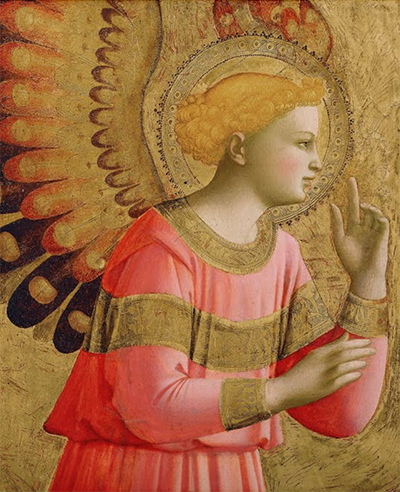This is part of a series of paintings by Fra Angelico between 1450 and 1455 that depicts the story in which the Archangel Gabriel broke the news to the Virgin Mary that she had been chosen to be the mother of Christ.
This masterpiece was brought to life in the Renaissance era with a representation a traditional theme aimed at forming part of the decorative scheme in the Florence Dominican convent. It is one of two panels that were once part of a large altarpiece just above the central painting. This painting was Fra Angelico's depiction of the moments leading the announcement of God’s will on the Virgin Mary. The second panel indicates Virgin Mary bowing her head, an indication that she had submitted to the will of God.
The painting is a clear depiction of the transition between the Gothic period and renaissance era as evidenced by the static, flat and unrealistic appearance of the Annunciatory Angel, at a time when subjects in paintings were supposed to achieve heights of singular elegance. The utilisation of the element of light in this art piece by Angelico is just revolutionary. He utilised Masaccio's approach in this painting by creating a figured that appears weighty, solid and situated in a seemingly designed space.
Another technique that is quite evident in this piece is the use of minimalistic component parts that was achieved because of Angelico's prior training as a manuscript illuminator. The intricacy of the Archangel Gabriel's figure is successfully brought out by Angelico's success in using different textures, especially in the wings feathered texture with high contrast between the wings and the halo.
Aquinas, a great painter associated with Thomism, a philosophical school based on his works, was a great influence on Fra Angelico's works because of his emphasis on the use of emotions in spiritual life and the harmony between grace and nature. These elements are at the core of Angelico's paintings. Another great influence on the career of Angelico was Alessio Baldovinetti that helped him achieve a mature style in his work, especially on a fresco he did with Andrea del Castagno. Other artists that were of great influence were Masaccio and St. Antoninus Pierozzi who later became Florence’s archbishop among others.
Some of the movements that Fra Angelico influenced were High Renaissance, Pre-Raphaelites and Romaneque art including famous artists like Dante Gabriel Rossetti, Rogier van der Weyden whose works are a depiction of Angelico's compositional structure and continues serving as a source of inspiration to many artists including pop artist Richard Hamilton.




